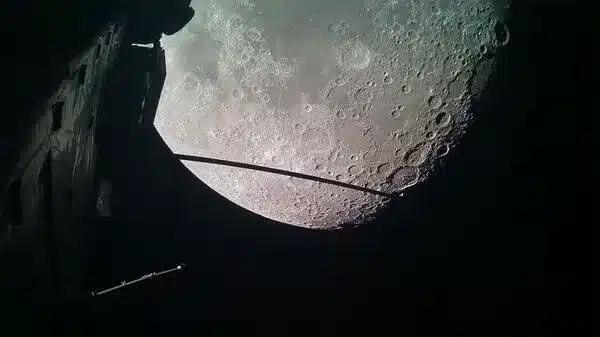Chandrayaan-3’s discovery:
- Chandrayaan-3’s Pragyan rover identified a rock type known as ferroan anorthosite in the lunar south pole region.
- This discovery is significant as it aligns with earlier observations made by the Apollo and Luna missions, confirming the theory that these rocks are remnants of an ancient magma ocean that once covered the moon.
What is the Lunar Magma Ocean (LMO)?
The Lunar Magma Ocean is a hypothesized early stage in the moon’s history when its surface was entirely molten. This ocean of magma is believed to have formed following a catastrophic impact between the early Earth and a Mars-sized body, leading to the formation of the moon.
- Ferroan Anorthosite: This rock type is crucial evidence of the LMO. As the magma began to cool and solidify, different minerals crystallized at various depths. Ferroan anorthosite, rich in calcium and aluminium, floated to the surface, forming the moon’s initial crust.
- Importance of the LMO: LMO helps scientists decipher the moon’s geologic history, including its differentiation process, where heavier materials sank, and lighter materials floated, leading to the layered structure we observe today.
Scientific implications:
- The presence of ferroan anorthosite supports the theory that the moon’s early crust was formed from a global magma ocean.
- This discovery also suggests that the moon has not experienced significant volcanic activity or plate tectonics, unlike Earth, preserving its ancient surface.
- General Relativity and Time Dilation: The discovery also ties into broader concepts like Einstein’s theory of general relativity, which explains how the moon’s lower gravity causes time to tick slightly faster than on Earth.
Key points:
- Impact hypothesis: The theory that the moon was formed from debris following a collision between the early Earth and a rogue planetary body.
- South Pole-Aitken basin: The largest impact crater in the solar system, near which Chandrayaan-3’s Pragyan rover conducted its studies.
Alpha Particle X-ray Spectrometer (APXS): The instrument used by Pragyan to identify the chemical composition of lunar soil.
Q1. What arе thе objеctivеs of Chandrayaan-3?
The primary objectives of Chandrayaan-3 include furthеr еxploration of thе moon’s surfacе, studying its minеral composition, analysing its gеology, and conducting experiments to gain a bеttеr understanding of the lunar environment.
Source: Chandrayaan’s Pragyan rover offers evidence of magma ocean on young moon – The Hindu
Last updated on June, 2025
→ UPSC Notification 2025 was released on 22nd January 2025.
→ UPSC Prelims Result 2025 is out now for the CSE held on 25 May 2025.
→ UPSC Prelims Question Paper 2025 and Unofficial Prelims Answer Key 2025 are available now.
→ UPSC Calendar 2026 is released on 15th May, 2025.
→ The UPSC Vacancy 2025 were released 1129, out of which 979 were for UPSC CSE and remaining 150 are for UPSC IFoS.
→ UPSC Mains 2025 will be conducted on 22nd August 2025.
→ UPSC Prelims 2026 will be conducted on 24th May, 2026 & UPSC Mains 2026 will be conducted on 21st August 2026.
→ The UPSC Selection Process is of 3 stages-Prelims, Mains and Interview.
→ UPSC Result 2024 is released with latest UPSC Marksheet 2024. Check Now!
→ UPSC Toppers List 2024 is released now. Shakti Dubey is UPSC AIR 1 2024 Topper.
→ Also check Best IAS Coaching in Delhi
























